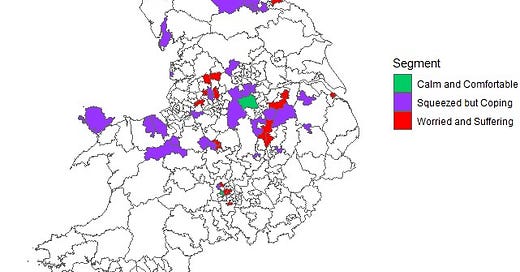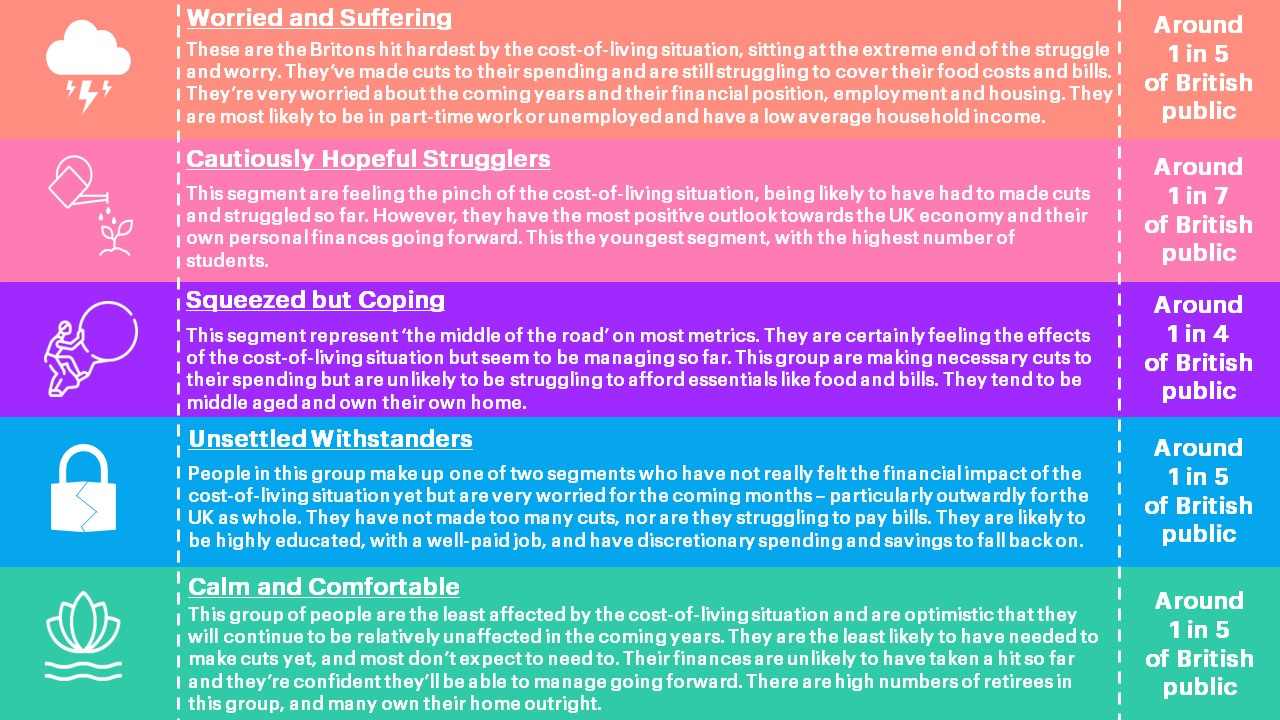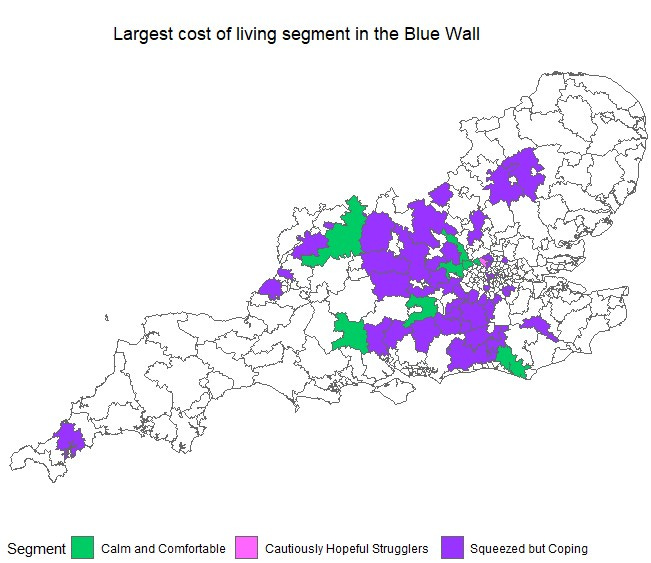The Political Consequences of the Cost of Living Crisis
How YouGov's 'Cost of Living' population segments break down across political walls
The Conservative Party is currently counting the cost of various political and economic fallouts in its vote intention figures. While there has been a slight narrowing of the gap between Sunak’s party and Labour in recent weeks, after a good few days of fairly positive news cycles for them, they remain some way behind.
At the start of 2022, then prime minister Boris Johnson and his government were very much in touch with Labour in the polls; while public frustration with inflation was already beginning filter through, and stories of lockdown-breaching parties in Number 10 were just emerging, vote intention leads for Keir Starmer’s party were in the order of just around 4 or 5 points.
Fast forward to March 2023, and after a series of damaging stories and events, ranging from the full ‘partygate’ fallout to the election of Liz Truss to leader and the mini economic crisis created by her fiscal policy announcements, that Labour lead has extended to around 20 points.
Currently, less than half of those who voted Conservative in 2019 tell us at YouGov they still plan to vote for Sunak’s party if an election were held tomorrow. A full 10% of them tell us they now plan to vote Labour.
Of course, the lead is not all down to self-inflicted Conservative wounds. The elephant squatting in the court of public opinion is the cost of living crisis.
With inflation soaring, energy bills rocketing, and wages struggling to keep pace, public anger with the way the government has handled the economy in reference to their household finances - not just the nation’s - has only anchored the Conservatives down in their polling mire.
But not everyone shares the same point of view, or the same experience, of the cost of living crisis. In turn, this correlates with very different values and opinions on the government’s handling of the crisis. As such, economic worry has become a very powerful predictor of voting behaviour.
Thinking ahead to 2024, the different geographical distributions of financial insecurity across the British electorate creates very different challenges for the Conservative party looking to hold on to as many seats from its 365 wins in 2019 as possible.
Cost of living and voting
Earlier this year, we released our YouGov Cost of Living Segmentation model, which placed every adult in the country in Britain into one five distinct groups. The segments range from the asset rich, low worry ‘Calm and Comfortable’, through the ‘Unsettled Withstanders’, ‘Squeezed but Coping’, ‘Cautiously Hopeful Strugglers’, to the financially troubled and highly concerned ‘Worried and Suffering’.
Last month, analysis of how these five distinct groups would vote in an election held the next day showed strong support for the Conservatives among the ‘Calm and Comfortable’ group, but also among the far-less financially secure ‘Cautiously Hopeful Strugglers’. Labour however were well ahead among the ‘Worried and Suffering’, ‘Squeezed but Coping’, and ‘Unsettled Withstanders’.
As well as divisions on asset richness, economic worry, and financial insecurity, the five groups are also dispersed in unique patterns across the country. No one constituency is quite like another in terms of its distribution of the five segments. Which, when combined with their varying vote intentions, makes for an extremely important fragment of Britain’s contemporary political landscape - the electoral geography of the cost of living.
This piece focuses on how Britain’s cost of living groups are distributed two distinct types of constituencies which the Conservatives must look to hold in 2024 if they are to have any chance of defending the majority won by Boris Johnson in 2019: the ‘Red Wall’ constituencies won from Labour in the midlands, north, and Wales, and the band Remain-voting, graduate-heavy, ‘Blue Wall’ constituencies in the South of England.
What do the segments want from the government?
One of the key findings of our initial cost of living research suggested that the ‘Calm and Comfortable’ were overall quite likely to think the government were already “doing everything they reasonably can to help people through the cost of living situation”.
But, on the other hand, the ‘Worried and Suffering’ told us quite clearly that they believed the government should be doing more - by a margin of 88%-4%. There was clear, overwhelming majority support for “doing more” among the ‘Squeezed but Coping’, and sizeable support for this suggestion among both the ‘Unsettled Withstanders’ and ‘Cautiously Hopeful Strugglers’.
Similarly, the ‘Calm and Comfortable’ were the most likely group to think that Jeremy Hunt’s Spring Budget was “fair”, and were far more supportive than other segments on government measures such as abolishing the lifetime allowance, creating new investment zones, and allowing companies to claim investment spending against their tax bills.
The ‘Worried and Suffering’ were the least likely to support all of those measures - followed by the ‘Squeezed but Coping’.
All of this research points in the same direction - very different priorities and principles for government action on the economy across the Cost of Living Segmentation groups.
How does the cost of living go down in the Red Wall?
Across the Red Wall, an estimated 22% fit into both the ‘Worried and Struggling’ and ‘Calm and Comfortable’ segments. Meanwhile, around 18% are ‘Unsettled Withstanders’, 23% are ‘Squeezed but Coping’, and 16% are ‘Cautiously Hopeful Strugglers’.
The ‘Worried and Suffering’ are significantly over-represented here versus the country as a whole. In fact, according to MRP analysis, out of these 50 seats, the ‘Worried and Suffering’ are the largest segment in 18. The ‘Squeezed but Coping’ are largest in 30, while in two it is the ‘Calm and Comfortable’.
So much of the framing of the 2024 election focused on how various policies and narratives will ‘go down in the Red Wall’. In that regard, the cost of living map is quite clear: this collection of Conservative-held seats contain some of the most financially vulnerable and economically insecure communities in the country, and (as we know from the research above) they are demanding that the government do more to help them.
With strong Labour vote intention leads among both the ‘Worried and Suffering’ and ‘Squeezed but Coping’ segments, it is perhaps no wonder that every constituency-level analysis of the Red Wall has forecasted total Conservative wipe-out there.
Any signs of Blue Wall financial woes?
Distributions of the YouGov Cost of Living Segments are markedly different in the Blue Wall than to its red equivalent. For one, only 13% of the public here are categorised as ‘Worried and Suffering’, while 21% are ‘Unsettled Withstanders’ and 24% are ‘Calm and Comfortable’. Over a quarter (26%) are ‘Squeezed but Coping’ and 16% are ‘Cautiously Hopeful Strugglers’.
Visualising the largest segments shows just how different these Conservative-held constituencies are those the aforementioned northern-bloc. In not one segment are the ‘Worried and Suffering’ largest. The ‘Calm and Comfortable’ outnumber everyone else in 9. In 43, the ‘Squeezed but Coping’ are most numerous, while in one constituency it’s the ‘Cautiously Hopeful Strugglers’.
The ‘Calm and Comfortable’ constituencies are mostly concentrated in a cluster in and around London, and a few constituencies dotted around the Wall’s southern and western sides. This is the segment with whom the Conservatives are currently doing best in terms of voting intention, and who are likely to think that the government are doing all they can vis-à-vis the crisis itself.
Everywhere else in the Blue Wall is a sea of purple - those for whom the cost of living crisis has meant cut backs and spending changes, but who are nonetheless on top of their bills and payments.
Overall, with financial security much higher in the Blue Wall, economic priorities in here will be markedly different than in the Red Wall.
What does this mean for 2024?
Thinking ahead to the next General Election - assumed to be some time in 2024 - the political geography of the cost of living crisis presents a striking problem for the Conservatives.
I might go so far as to argue that there is perhaps no greater articulation of the breadth of the voter coalition that the Conservatives put together in 2019 than this: in the Red Wall, over one-third of constituencies are topped by the ‘Worried and Suffering’, while in the Blue Wall, the ‘Calm and Comfortable’ are the most populous group in almost 20%.
Relatedly, we know there are strong differences on attitudes toward Brexit and the European Union between the two areas - another key dividing line in the Conservative voter coalition, which has often been correlated with class and relative levels of economic security.
So, as Sunak and his strategists look for ways to defend their majority against a rejuvenated Labour and a determined Keir Starmer, they face a situation where two vital parts of their base are pulling in two very different directions regarding the cost of living, its impact on their daily lives, and what (if anything) they think the government should be doing to help people more.
How does the party create an electoral and policy programme which will provide the financial support and economic intervention needed in the Red Wall, but speak to voter priorities and maintain support in the more affluent and economically secure Blue Wall?







